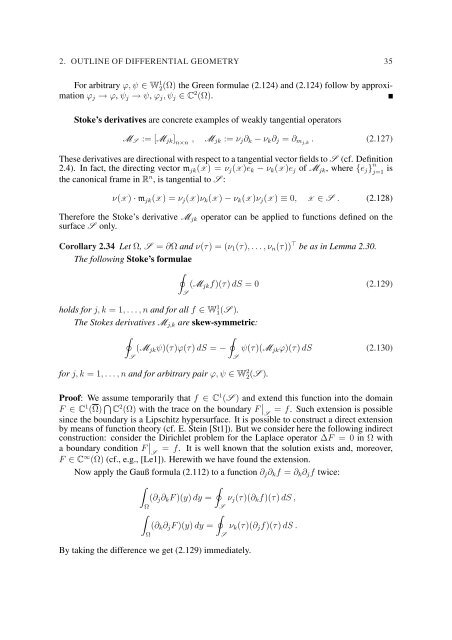EQUATIONS OF ELASTIC HYPERSURFACES
EQUATIONS OF ELASTIC HYPERSURFACES
EQUATIONS OF ELASTIC HYPERSURFACES
You also want an ePaper? Increase the reach of your titles
YUMPU automatically turns print PDFs into web optimized ePapers that Google loves.
2. OUTLINE <strong>OF</strong> DIFFERENTIAL GEOMETRY 35<br />
For arbitrary ϕ, ψ ∈ W 1 2(Ω) the Green formulae (2.124) and (2.124) follow by approximation<br />
ϕ j → ϕ, ψ j → ψ, ϕ j , ψ j ∈ C 2 (Ω).<br />
Stoke’s derivatives are concrete examples of weakly tangential operators<br />
M S := [M jk ] n×n<br />
, M jk := ν j ∂ k − ν k ∂ j = ∂ mj,k . (2.127)<br />
These derivatives are directional with respect to a tangential vector fields to S (cf. Definition<br />
2.4). In fact, the directing vector m jk (X ) = ν j (X )e k − ν k (X )e j of M jk , where {e j } n j=1 is<br />
the canonical frame in R n , is tangential to S :<br />
ν(X ) · m jk (X ) = ν j (X )ν k (X ) − ν k (X )ν j (X ) ≡ 0, X ∈ S . (2.128)<br />
Therefore the Stoke’s derivative M jk operator can be applied to functions defined on the<br />
surface S only.<br />
Corollary 2.34 Let Ω, S = ∂Ω and ν(τ) = (ν 1 (τ), . . . , ν n (τ)) ⊤ be as in Lemma 2.30.<br />
The following Stoke’s formulae<br />
∮<br />
(M jk f)(τ) dS = 0 (2.129)<br />
S<br />
holds for j, k = 1, . . . , n and for all f ∈ W 1 1(S ).<br />
The Stokes derivatives M j,k are skew-symmetric:<br />
∮<br />
∮<br />
(M jk ψ)(τ)ϕ(τ) dS = − ψ(τ)(M jk ϕ)(τ) dS (2.130)<br />
S<br />
S<br />
for j, k = 1, . . . , n and for arbitrary pair ϕ, ψ ∈ W 2 2(S ).<br />
Proof: We assume temporarily that f ∈ C 1 (S ) and extend this function into the domain<br />
F ∈ C 1 (Ω) ⋂ C 2 (Ω) with the trace on the boundary F ∣ S<br />
= f. Such extension is possible<br />
since the boundary is a Lipschitz hypersurface. It is possible to construct a direct extension<br />
by means of function theory (cf. E. Stein [St1]). But we consider here the following indirect<br />
construction: consider the Dirichlet problem for the Laplace operator ∆F = 0 in Ω with<br />
a boundary condition F ∣ S<br />
= f. It is well known that the solution exists and, moreover,<br />
F ∈ C ∞ (Ω) (cf., e.g., [Le1]). Herewith we have found the extension.<br />
Now apply the Gauß formula (2.112) to a function ∂ j ∂ k f = ∂ k ∂ j f twice:<br />
∫<br />
∮<br />
(∂ j ∂ k F )(y) dy = ν j (τ)(∂ k f)(τ) dS ,<br />
∫<br />
Ω<br />
Ω<br />
∮<br />
(∂ k ∂ j F )(y) dy =<br />
By taking the difference we get (2.129) immediately.<br />
S<br />
S<br />
ν k (τ)(∂ j f)(τ) dS .

















